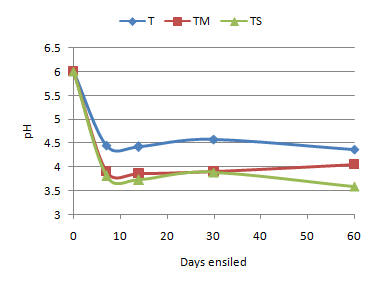|
Back to Content
|
MEKARN Conference 2010
Live
stock production, climate change and resource depletion
|
|
Study on the use of ensiled taro (Colocasia
esculenta) and cassava (Manihot esculenta Crantz) leaves as protein
sources in diets for pigs in the uplands conditions in central Vietnam
Nguyen Thi Hoa Ly, Tran Thanh Hai and T R Preston*
Hue
University of Agriculture and Forestry, Vietnam
*UTA, TOSOLY, AA48 Socorro, Santander, Colombia
nguyenhoaly@gmail.com
Abstract
The effects of additive at 4% from
molasses and without molasses with hammer or without hammer after chopping were
used to study the quality of taro leaves or taro foliages silage.
A total of 6 treatments with 3
replicates each at time measuring were used for ensiling during 0 to 60 days.
There was a marked decrease in pH after 7 days and the pH remained low
and stable at 3.6-4.6 after 60 days ensiling in all treatments. There were
significant differences in DM content of the silages with time of ensiling. The
crude protein content decreased with time from 0 to 60 days after ensiling for
all treatment groups (P<0.001). The CP in the taro foliages about 17- 17.6 % (in
DM) were lower than in taro leaves (CP content 25 -26 % in DM) after 60 days
ensiling. It is concluded that taro leaves or foliage taro can be preserved
successfully with or without 4 % molasses additive. The silages can be stored
for at least two months.
The three growing pigs of Van Pa
about 5 months of age, with an average body weight of 21.6
± 1.24 kg in a 3 x 3 Latin Square
arrangement were three levels of mixture of ensiled taro leaves and cassava
leaves. Protein from a 50 : 50 (DM basis) mixture of ensiled taro leaves and
cassava leaves replaced the protein from fish meal in
diet of growing Van Pa pigs at levels of 0, 50 and 100 %. The experiment
lasted for a total of 30 days. Each of the three experimental periods was 10
days, comprising 5 days of adaptation to each diet followed by 5 days of
collection of faeces and urine. The Van Pa pigs were kept in individually in
metabolism cages for 30 days for familiar with new feed and house before carried
out experiment.
Increasing levels protein from
a mixture ensiled taro leaves and cassava leaves replacing protein from fish
meal were significant decreased in the daily intake of DM, OM, CP and CF in
growing Van Pa pigs. However, there were no
significant differences in the digestibility of DM, OM, CP and N
retained/N digested among treatments (P>0.05).
Mean values for digestibility CP (%) in Van Pa growing pigs fed cassava root
meal and rice bran and increasing proportions (0 to 100%) of protein from a
mixture ensiled taro leaves and cassava leaves replacing protein from fish meal
were: 76 %; 68 % and 69 %, respectively; N retained/N digested of Van Pa pigs
were 67 %, 62 % and 61 %, respectively.
Mixture from a 50 : 50 (DM basis) of ensiled taro leaves
and ensiled cassava leaves can be used as a protein replace fishmeal for Van
Pa pigs.
Key words: ensiled taro leaves; cassava
leaves; digestibility; Van Pa growing pigs
 |
 |
| Figure 1: Changes in pH for taro leaves ensiled alone
(T), with 4% molasses (TM) or taro leaves + stem (TS) |
Figure 2: Relationship between DM intake and N retention in pigs
fed increasing proportions of taro leaf silage and cassava leaf
silage replacing fish meal |

